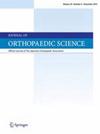Capsular and fascial closure with barbed sutures reduces blood loss compared to traditional interrupted sutures in total hip arthroplasty
IF 1.5
4区 医学
Q3 ORTHOPEDICS
引用次数: 0
Abstract
Background
STRATAFIX, a recently introduced barbed suture device, incorporates self-anchoring, knotless sutures with higher tensile strength and enhanced tissue-holding capacity compared to traditional braided absorbable sutures. This study aimed to compare the efficacy of barbed sutures and interrupted sutures in capsular and fascial closure during total hip arthroplasty.
Methods
We retrospectively reviewed the records of patients who underwent total hip arthroplasty between April 2017 and March 2021. Overall, 547 patients were evaluated, comprising 77 men and 470 women (mean age: 64.5 years). Among them, 330 patients were in the interrupted suture (control) group, while 217 were in the barbed suture (BS) group. Data on surgical time, perioperative hemoglobin, length of hospital stay, complications such as transfusions and delayed wound healing, and dislocation rates were collected during the latest outpatient follow-up and compared between the two groups.
Results
No differences were observed in intraoperative blood loss between the groups. However, the BS group exhibited significantly longer operative time, as well as significantly lower postoperative blood loss, total blood loss, and postoperative hemoglobin drop compared to the control group. Dislocation was reported in two cases within the control group, whereas no instances were recorded in the BS group.
Conclusion
The use of barbed sutures demonstrated effectiveness in reducing perioperative blood loss for capsular and fascial closure during total hip arthroplasty.
在全髋关节置换术中,与传统的间断缝合相比,使用倒钩缝合线进行囊膜和筋膜缝合可减少失血量。
背景:STRATAFIX 是最近推出的一种带刺缝合装置,与传统的编织可吸收缝线相比,它采用了自锚式无结缝线,具有更高的抗张强度和更强的组织固定能力。本研究旨在比较倒钩缝合线和间断缝合线在全髋关节置换术中用于髋关节囊和筋膜闭合的效果:我们回顾性地查看了 2017 年 4 月至 2021 年 3 月期间接受全髋关节置换术的患者记录。共评估了 547 例患者,其中男性 77 例,女性 470 例(平均年龄:64.5 岁)。其中,间断缝合(对照)组有 330 名患者,倒钩缝合(BS)组有 217 名患者。在最近一次门诊随访中收集了两组患者的手术时间、围术期血红蛋白、住院时间、输血和伤口延迟愈合等并发症以及脱位率等数据,并进行了比较:结果:两组术中失血量无差异。然而,与对照组相比,BS 组的手术时间明显更长,术后失血量、总失血量和术后血红蛋白降幅也明显更低。对照组有两例脱位,而 BS 组无脱位记录:结论:在全髋关节置换术中使用带刺缝合线进行关节囊和筋膜缝合可有效减少围手术期失血。
本文章由计算机程序翻译,如有差异,请以英文原文为准。
求助全文
约1分钟内获得全文
求助全文
来源期刊

Journal of Orthopaedic Science
医学-整形外科
CiteScore
3.00
自引率
0.00%
发文量
290
审稿时长
90 days
期刊介绍:
The Journal of Orthopaedic Science is the official peer-reviewed journal of the Japanese Orthopaedic Association. The journal publishes the latest researches and topical debates in all fields of clinical and experimental orthopaedics, including musculoskeletal medicine, sports medicine, locomotive syndrome, trauma, paediatrics, oncology and biomaterials, as well as basic researches.
 求助内容:
求助内容: 应助结果提醒方式:
应助结果提醒方式:


